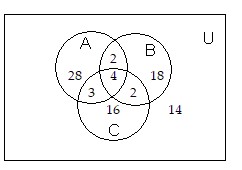Solve the equation. =
= 
A. x = -4, x = 6
B. x = 4, x = 6
C. x = -4, x = -6
D. x = -  , x =
, x = 
Answer: C
You might also like to view...
Use the theorem on bounds to establish the best integral bounds for the roots of the equation.-7x4 - 2x3 + 6x + 9 = 0
A. No bound can be determined. B. -2 < x < 2 C. -1 < x < 2 D. -1 < x < 1
Use Cramer's rule to solve the system of equations. If D = 0, use another method to determine the solution set.9x + 5y = -38-7x - 2y = 39
A. Cramer's rule does not apply since D = 0; ? B. {(-7, 5)} C. {(-8, 6)} D. {(-7, 6)}
Determine whether the two triangles are congruent. If they are, state by what theorem they are congruent. The triangles are not to scale.
 figure 3.png)
a. not congruent
b. congruent by AAA
c. congruent by ASA
d. congruent by SAS
e. congruent by AAS
Use the information given in the figure. How many are not in C?
How many are not in C?
A. 62 B. 57 C. 48 D. 60